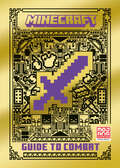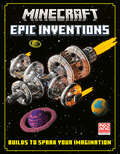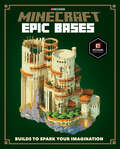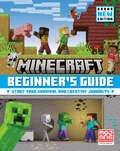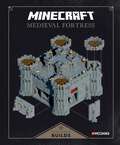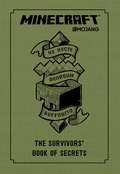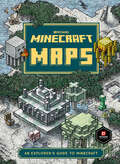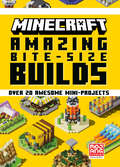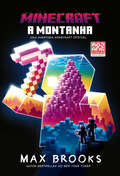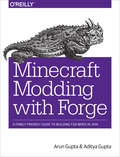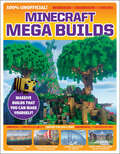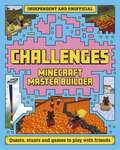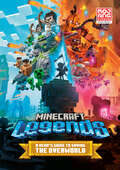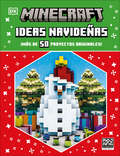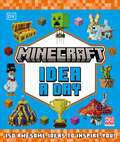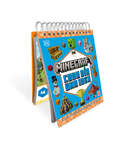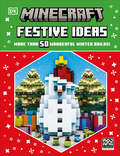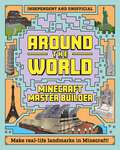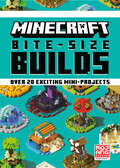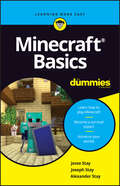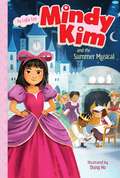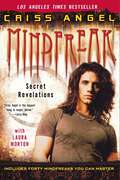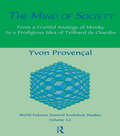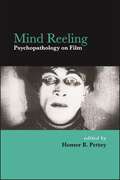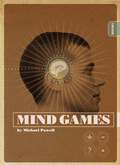- Table View
- List View
Minecraft: Guide to Combat (Minecraft)
by Mojang AB The Official Minecraft TeamLearn how to survive and thrive in Minecraft with this brand-new guide! With insider info and tips from the experts at game-creator Mojang on how to defeat mobs and defend your base, this is a must-have, fully illustrated guide to combat. Don your armor, pick up your sword and charge headfirst into Minecraft: Guide to Combat—the only book you need to take your game to the next level. Read how to craft the deadliest weapons and enchant them with mystical powers, discover the vicious mobs that you&’ll go toe-to-toe with, and learn crafty strategies that will help you best your friends in PVP. With so much to explore, there&’s sure to be something for &’crafters of every level.
Minecraft: Epic Inventions (Minecraft)
by Mojang AB The Official Minecraft TeamTwelve mind-blowing Minecraft builds to spark your imagination.Epic Inventions contains twelve incredible builds to inspire you to construct the most inventive builds in Minecraft. There's an intergalactic space station, an ancient temple, a kawaii waterways course, a giant meeple bedroom, an animal sanctuary, plus many more. Each build is presented to you by its builder—a construction expert eager to share their tips with you. As well as learning how to choose blocks and construct amazing builds, you'll also learn some excellent pro builder tips like how to terraform the landscape.
Minecraft: Epic Bases (Minecraft)
by Mojang ABDiscover new and exciting Minecraft base builds, with construction tips, blueprint spreads, and fun locations—written in official partnership with the experts at game-creator Mojang.Are you an expert builder? Looking for inspiration for your next epic build? Then the search is over!Visit the legendary bases of The Twelve, a guild of expert builders, who are ready to showcase their most stunning creations, including flying airships and underwater lairs. Learn their top tips and tricks for making incredible bases in a variety of themes, and follow their expert advice to create challenging structures and complex redstone mechanisms.Full of thematic builds and unique features, this book of exceptional bases will spark the imagination of Minecrafters young and old.
Minecraft: Beginner's Guide (Minecraft)
by Mojang AB The Official Minecraft TeamDive into Minecraft headfirst with this all-new beginner&’s guide that will teach you everything you need to know for starting your Minecraft journey, whether that be in Survival mode or Creative. Are you new to Minecraft or still not quite getting the hang of it? Then this book is for you! Join characters such as Miss Hap, Sir Vival and Bill Ding on an adventure through the Overworld, to discover how you can ace your early game.Learn everything from what happens when you die and how to avoid it to how to feed yourself and where to find the cutest mobs. So what are you waiting for? Pick up the book and start your epic adventure!Full of fun and humor, this guide is perfect for kids of all ages.
Minecraft: An Official Mojang Book (Minecraft)
by Mojang AB The Official Minecraft TeamHave you ever wanted to create your own legendary medieval kingdom to rule over? Well, now you can, with Minecraft Exploded Builds: Medieval Fortress. Learn how to design, build, and customize every part of your castle and the surrounding area, from sturdy walls and deadly traps to dank, dark dungeons and sprawling villages. Each build has an exploded view to show you exactly which blocks to use, plus extra ideas to make every part of your kingdom unique. Packed with interesting facts about medieval life, full-color illustrations, and a foldout depicting the epic scale of the kingdom, this official Mojang book has dozens of building ideas to ignite the imaginations of Minecrafters of all ages.This ebook is best viewed on a color device with a larger screen.Collect all of the official Minecraft books:Minecraft: The IslandMinecraft: The CrashMinecraft: The Lost JournalsMinecraft: The Survivors&’ Book of SecretsMinecraft: Exploded Builds: Medieval FortressMinecraft: Guide to ExplorationMinecraft: Guide to CreativeMinecraft: Guide to the Nether & the EndMinecraft: Guide to RedstoneMinecraft: MobestiaryMinecraft: Guide to Enchantments & PotionsMinecraft: Guide to PVP MinigamesMinecraft: Guide to FarmingMinecraft: Let&’s Build! Theme Park AdventureMinecraft for Beginners
Minecraft: An Official Mojang Book
by Mojang Ab The Offical Minecraft TeamAn all-new official Minecraft™ guidebook full of tips to fend off mobs and withstand the wild!This official Minecraft™ book contains the collective knowledge of the Survivors: an underground group of Minecraft™ experts who have been around since the days of Alpha. You’re probably wondering why you’ve never heard of us. It’s because we’re THAT good. We’re experts at covert ops. Misdirection is our middle name. We’re invisible up until the exact moment we want you to see us. . . . Our successes are undeniably impressive: we’ve battled the Overworld mobs, dealt with enemy factions, and defeated the ender dragon multiple times. Study this book carefully and you just might manage to stay alive as long as we have. THE CHIEF
Minecraft: An Explorer's Guide to Minecraft (Minecraft)
by Mojang AB The Official Minecraft TeamDiscover the hidden corners of the many weird and wonderful locations in Minecraft with this beautifully illustrated, full-color guide--written in official partnership with the experts at game-creator Mojang.Are you ready for an adventure? Minecraft: Maps is a visual guide to the Minecraft landscape, created by an explorer on a quest to find the most valuable loot while avoiding danger. Explore each of the fifteen major biomes through highly detailed, illustrated maps, then read the explorer's notes about the unique features and discover an inspirational themed build idea for each.A beautifully illustrated visual guide in its own right, Minecraft: Maps is also a survival tool. You'll learn which biomes are home to the most dangerous mobs, where to look for exclusive blocks, how to find naturally generated structures and the best places to search for loot. Once you've discovered each biome you can get building--construct an ice palace in the ice plains biome and an entire village suspended in the tree canopy above the jungle floor.Biomes: Badlands, Dark Forest, Desert, Forest, Jungle, Mountains, Mushroom Fields, Ocean, Plains, Savanna, Snowy Tundra, Swamp, Taiga, The Nether, The End
Minecraft: Amazing Bite-Size Builds (Minecraft)
by Mojang AB The Official Minecraft TeamLearn how to design, build and customize 20 mini-projects in Minecraft, from firefighter planes and deep-sea submarines to hidden bunkers and arcade games. There&’s even a superhero flying school! With detailed instructions, block hacks and build tips, this book will teach you new tricks and help you practice old skills as you create bite-size builds to impress your friends in Minecraft.
Minecraft: A Montanha
by Max BrooksUMA AVENTURA IMPERDÍVEL DO UNIVERSO MINECRAFT! Ele não sabe o seu nome, nem onde está, nem como sobreviver, nem como voltar para casa. E no mundo de Nether, com uma ajuda preciosa, luta pela vida contra mobs e zombies. Uma lição sobre amizade e sobrevivência.
Minecraft Modding with Forge
by Arun Gupta Aditya GuptaPlaying Minecraft is a lot of fun, but the game is more engaging, entertaining, and educational when kids learn how to build mods--small programs that let them modify game elements and add content. This family-friendly guide teaches kids and parents how to create mods of different types, using the Minecraft Forge modding tool. No programming experience is needed.You'll not only build some amazing mods with the book's easy-to-follow instructions, but you'll also learn how to work with Java, the same programming language that Minecraft uses. Why wait? Get started with computer programming and be more creative with Minecraft while you're at it!This book will help you:Learn the fundamentals of Minecraft Forge and other tools, such as EclipseStart out by building and testing a simple chat message modBuild cool mods that make things explode on contact, and help entities jump higher and climb wallsIntroduce new Minecraft content, including commands, blocks, items, and recipes and texturesWork with Java fundamentals such as classes, methods, annotations, control structures, and arraysLearn techniques for creating your own modsThis guide is based on workshops the authors deliver to kids around the world.
Minecraft Mega Builds: An AFK Book (Media tie-in)
by Future PublishingThe perfect guide for any builder that wants to take their Minecraft construction skills to new heights!From weird to awesome, this unofficial guide has it all! With step-by-step instructions you can tackle some of the biggest, wackiest, and coolest Minecraft builds of all time. Whether you are just starting out, trying to perfect your building skills, or searching for inspiration on your next megabuild, you won't want to miss the Minecraft Unofficial Build guide!
Minecraft Master Builder Challenges (Minecraft Master Builder #5)
by Welbeck Children's BooksIf you're playing Minecraft online with friends, you need this cool new collection of amazing Minecraft challenges! This book gives you simple, step-by-step instructions for building amazing arenas, setting up fun quests, and organising server-wide games.Difficulty levels range from easy-to-play games like hide-and-seek and racing, to fun building challenges, and all the way up to huge epic tasks involving all your friends. Best of all, you don't need to mod your copy of Minecraft-all the challenges here can be shared with your friends without any extra downloads or alterations to regular Minecraft. If you're looking to create some spectacular challenges to amuse and amaze your friends, look no further!
Minecraft Legends: A Hero's Guide to Saving the Overworld (Minecraft)
by Mojang AB The Official Minecraft TeamPrepare for the upcoming Minecraft: Legends video game with this official guide from Mojang, featuring tips, tricks, and strategies to help you defeat the Piglin threat and save the Overworld! The Overworld needs a hero. Is it you? The Overworld is on the brink of destruction. The piglins have arrived, and they&’re hungering to take it for themselves. Gather your strength, inspire unexpected friends and lead them into battle before the piglins&’ Nether corruption devours all. Inside these pages, you&’ll discover game-winning strategies, from combat hacks to building tips, and learn what to expect from the piglin hordes and their bases. This is your ultimate guide to driving the piglins back to the Nether.
Minecraft Ideas navideñas (Festive Ideas)
by DK¡Encuentra la inspiración con más de 50 ideas de construcción, juegos y actividades de Navidad!Perfecto para los fans más creativos, este libro está lleno de ideas y consejos útiles para llevar a cabo construcciones navideñas del mundo de Minecraft. Construye una casa de pan de jengibre, una adorable familia de pingüinos o una arena para peleas de bolas de nieve con gólems, y enfréntate a los desafíos más divertidos con Minecraft Ideas navideñas.© 2024 Mojang AB.------------------------You won’t run out of building ideas with this magical stocking-stuffer, featuring more than 50 festive building ideas, games, and activities!Packed with inspirational ideas and tips for Minecraft holiday builds, Minecraft Festive Ideas is perfect for creative Minecraft fans who want to build a fun and festive winter wonderland. Building ideas include a gingerbread house, an adorable family of penguins, an arena for a snow golem snowball fight, merry Minecraft challenges suitable for younger players, and much more!© 2024 Mojang AB.
Minecraft Idea a Day: Packed with Hundreds of Ideas to Inspire You!
by DKDiscover a new Minecraft build idea to inspire you each day!Get creative with 150 awesome Minecraft builds, from secret bases, cute animals, and dream homes, to supersized landmarks, mob builds and much more!Whether it’s a bouncy castle, creeper maze, swamp monster, rainbow bridge, axolotl house, or giant hotdog, each day brings a new and totally random, super-fun surprise. Plus, get top tips on how to level-up your Minecraft building skills.© 2024 Mojang AB.
Minecraft Idea a Day: Packed with Hundreds of Ideas to Inspire You!
by DK¡Pasa las páginas de este libro y encuentra la inspiración cada día con una nueva idea de construcción de Minecraft!Da rienda suelta a tu creatividad con 150 increíbles construcciones de Minecraft, desde bases secretas, animales adorables y casas de ensueño hasta monumentos gigantes y mucho más. Con un formato vertical encuadernado en espiral, es perfecto para ponerlo sobre tu escritorio o mesita de noche, y para pasar un rato divertido con familiares y amigos. Un castillo inflable, un laberinto de enredaderas, un monstruo de pantano, un puente arcoíris, una casa de axolotes o un hot dog gigante…Cada día encontrarás una sorpresa nueva, totalmente aleatoria y súper divertida, además de los mejores consejos para mejorar tus habilidades como constructor de Minecraft.© 2024 Mojang AB.------------------------------------------------------------Flip the page and discover a new Minecraft build idea to inspire you daily!Get creative with 150 awesome Minecraft builds, from secret bases, cute animals, and dream homes to supersized landmarks, mob builds, and much more! The stand-up, spiral-bound format is perfect for displaying next to your screen and enjoying with family and friends as you find inspiration for your next brilliant build.Whether it’s a bouncy castle, creeper maze, a swamp monster, rainbow bridge, axolotl house, or giant hotdog, each day brings a new and totally random, super-fun surprise. Plus, get top tips on how to level up your Minecraft-building skills.© 2024 Mojang AB.
Minecraft Festive Ideas: More Than 50 Wonderful Winter Builds
by DKYou won’t run out of building ideas with this magical stocking-stuffer, featuring more than 50 festive building ideas, games, and activities! Packed with inspirational ideas and tips for Minecraft holiday builds, Minecraft Festive Ideas is perfect for creative Minecraft fans who want to build a fun and festive winter wonderland. Building ideas include a gingerbread house, an adorable family of penguins, an arena for a snow golem snowball fight, merry Minecraft challenges suitable for younger players, and much more! © 2023 Mojang AB.
Minecraft Builder - Around the World: Independent and Unofficial
by Mortimer Children's BooksTravel the world in Minecraft! This easy-to-follow guide is filled with detailed instructions on how to make your own versions of the world's greatest landmarks. It includes straightforward instructions on how to build 13 different structures from around the world, including the Statue of Liberty, the Easter Island Heads, Sydney Opera House, Burj Khalifa, the Eiffel Tower, and many more.Builds range in difficulty, so there's something for every reader to try. Plus, every section is filled with cool info about the world's greatest wonders, meaning this is the perfect title for young learners. It's a fantastic way to combine geography, history and creativity into an amazing, fulfilling Minecraft experience.
Minecraft Bite-Size Builds (Minecraft)
by Mojang AB The Official Minecraft TeamDiscover new and exciting Minecraft builds made easy, broken down into manageable pieces—written in official partnership with the experts at game-creator Mojang.Learn how to design, build and customize 20 mini-projects in Minecraft, from firefighter planes and deep-sea submarines to hidden bunkers and mini arcade games. There's even a superhero flying school! Each build is accompanied by exploded views and step-by-step, fully-illustrated guides and detailed instructions to show you how to complete each build from start to finish. Informative text will help you with your construction understanding and encourage you to use your new knowledge to create your very own builds.
Minecraft Basics For Dummies
by Jesse Stay Joseph Stay Alex StayThe easy way to get started with Minecraft Want to creep into the biggest video game of all time? Grab your pickaxe and let's go! Minecraft Basics For Dummies helps you (or your kids) get started and join the infinite online world that keeps millions of players of all ages engaged every day. Inside this portable-trim book, crafters will get all the tips and tricks needed to get started—on their own or with multiple players—in each of the three gameplay modes. Choose a platform and download the game Navigate, collect resources, and build structures Defend your creations against monsters Manage parental controls to keep kids safe while playing online Become a Minecraft master by defeating the Ender Dragon Unleash your creativity, elevate family game night, and have a ton of fun joining more than 141 million players in the online world of Minecraft!
Mindy Kim and the Summer Musical (Mindy Kim #9)
by Lyla LeeFresh off the Boat meets Junie B. Jones in this adorable chapter book series following Mindy Kim, a young Asian American girl—in this ninth novel, Mindy steps into the spotlight.Mindy can&’t wait to be in a local community theater production of Cinderella with her BFF, Sally! Mindy has her sights on the lead role. But instead of Cinderella, Mindy ends up being cast as the evil stepsister! Mindy is worried that means people might see her as mean. Can Mindy figure out a way to make the role her own?
Mindfreak: Secret Revelations
by Laura Morton Criss AngelA Los Angeles Times bestseller, Mindfreak: Secret Revelations is the spellbinding memoir of stage and television’s master magician—Criss Angel.The star of Mindfreak—the most astonishing and provocative mystifier of the twenty-first century—Criss Angel shares his philosophy of life and magic, goes behind the scenes of his groundbreaking A&E TV series, and reveals the secrets to forty mind-blowing illusions that you can master!“An amazing illusionist. The best I’ve ever seen.” —Howard Stern“I don’t think there is anyone in magic right now who has captured the public interest more than Criss Angel.” —Penn Jillette“Criss Angel is the biggest thing in magic, period.” —Larry King“Criss Angel—part Cirque de Soleil freak, part magician, part street performance artist, part musician, part dancer—has taken magic and illusion from the realm of cheesola to the realm of art.” —New York Post
Mind of Society
by ProvencalFirst Published in 1999. Routledge is an imprint of Taylor & Francis, an informa company.
Mind Reeling: Psychopathology on Film (SUNY series, Horizons of Cinema)
by Homer B. PetteyMind Reeling investigates how cinema displays and mirrors psychological disorders, such as bipolar disorder, amnesia, psychotic delusions, obsessive compulsive behavior, trauma, paranoia, and borderline personalities. It explores a range of genres, including biopics, comedies, film noirs, contemporary dramedies, thrillers, Gothic mysteries, and docufictions. The contributors open up critical approaches to audience fascination with film depictions of serious disturbances within the human psyche. Many films examined here have had little scholarly attention and commentary. These essays focus on how cinematic techniques contribute to popular culture's conception of mental dysfunction, trauma, and illness. This book reveals the complex artistic and generic patterns that produce contemporary images of psychopathology in cinema.
Mind Games
by Michael PowellFifty ways to unlock the mysterious potential in your brain through tricks, applied science, and relearning the way you think.This fascinating book reveals the secrets of the most powerful organ in the body—the mind. From deceiving a lie detector test, winning a challenging game of chess, mastering pain, walking on fire, and foretelling the future, Mind Games provides step-by-step instructions for performing fifty mental feats ranging from the merely impressive to the scarcely believable. Only you can judge what is truly possible as you harness your own enormous power and tap into your brain’s full potential to perform tasks you never imagined you could. Mind Games is a complete practical guide to exploring and building your own mental powers.
